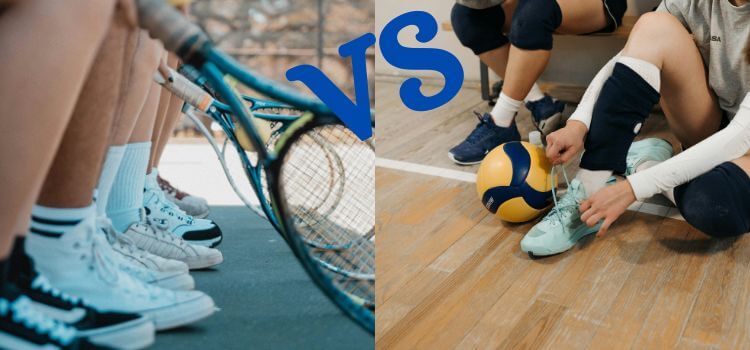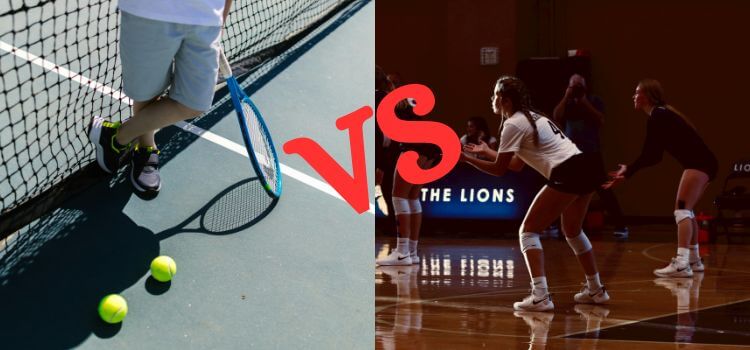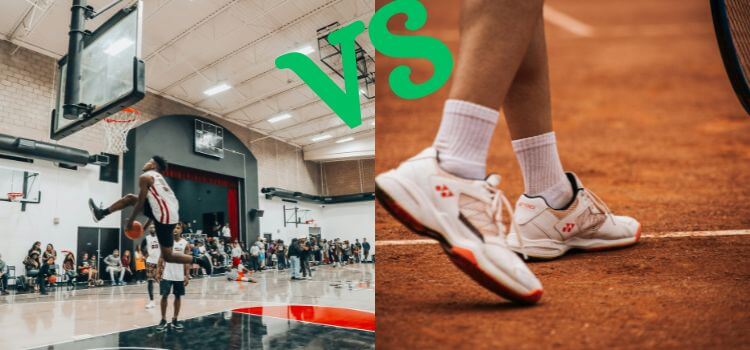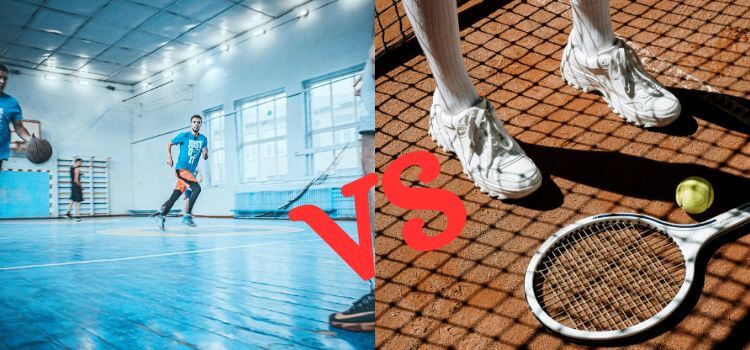Volleyball shoes and tennis shoes differ in design and functionality. Key features vary to cater to each sport’s unique demands.
Athletes recognize the significance of proper footwear in enhancing performance and reducing injury risk. This understanding has led to specialized shoes for specific sports, notably volleyball and tennis. Both court-based games, these sports involve agility, quick directional changes, and impactful movements, necessitating footwear tailored to these activities.
Volleyball shoes prioritize cushioning and stability for jumps and lateral movements. In contrast, tennis shoes focus on providing grip and flexibility for swift, repetitive sprints and pivots. Selecting the right shoe is not just about comfort; it’s a strategic choice that can influence an athlete’s game.

Therefore, when contemplating volleyball vs. Tennis shoes, one should consider the distinct qualities that can support their athletic endeavors on the court, ensuring safety and performance are addressed. By diving into the intricacies of each shoe type, we can better appreciate the thoughtful engineering behind athletic footwear dedicated to volleyball and tennis enthusiasts.
Introduction To Court Shoes
Imagine playing sports with the wrong shoes. Your feet ache. You can only move slowly. It feels wrong. That’s why finding the right court shoes is vital. Court shoes boost your game. They fit the sport. They protect your feet. Your shoes are as important as the ball. Let’s dive into the world of court shoes.
The Role Of Shoes In Sports Performance
Good sports shoes support. They can change the game. They help you move better. Quick stops. Fast runs. Safe jumps. They make it all easier. The wrong ones? They can hurt. Slow you down, even cause accidents. So, top players pick their shoes with care.
Volleyball And Tennis Footwear Dynamics
Volleyball shoes and tennis shoes look similar. But they have different features. Let’s compare.
| Volleyball Shoes | Tennis Shoes |
| Lightweight for quick moves | Built for lateral support |
| More cushion for jumps | Durable souls for hard courts |
| Grip for smooth floors | Varied tread patterns for grip |
Volleyball shoes aid high jumps and quick stops. Tennis shoes give stability for quick side moves. Each shoe matches the court’s needs. The right pair helps athletes shine.
Analyzing Volleyball Shoes
Let’s dive deep into the world of volleyball shoes. Knowing what sets them apart is critical to ace on the court. These shoes are more than just sneakers. They are specialized gear designed for the sport. Let’s break down their features.

Design Features For Quick Movements
Volleyball demands agility and speed. Hence, the design of its shoes caters to these needs. Lightweight materials are a must. So is flexibility. Here’s how volleyball shoes help players move swiftly:
- Grippy soles prevent slips during quick changes in direction.
- Reinforced toe areas guard against drag during dives.
- Low-cut styles give ankles freedom to move.
- A secure fit ensures the foot stays in place during jumps.
Cushioning And Stability In Volleyball Footwear
Players need support and comfort for the game’s impact. That is where cushioning and stability come into play. Volleyball shoes have features such as:
- A shock-absorbing midsole reduces knee and ankle stress.
- Gel or foam padding lessens landing impact.
- A sturdy heel counter enhances stability.
- Wide soles distribute weight evenly.
These elements provide players with a safe and stable base to perform their best.
Breaking Down Tennis Shoes
Exploring the intricate design of tennis shoes, we see they cater to the sport’s unique demands. Tennis shoes offer features tailored for rigorous court action. Let’s examine the key characteristics that set them apart, especially compared to volleyball shoes.
Traction And Sole Durability For Lateral Movements
Tennis shoes come with soles engineered for optimal grip on the court. This is crucial because tennis involves a lot of quick side-to-side movements. Traditional tennis shoe soles feature a herringbone pattern. This pattern boosts traction and aids in swift lateral transitions. When looking at durability, the soles are crafted from non-marking materials that offer long-lasting performance. Consider the following aspects:
- Thick outsoles: Provide enduring wear
- Reinforced high-wear areas: Combat sole degradation

Breathability And Fit For Long Matches
The design of tennis shoes also emphasizes comfort and fit. Players spend hours on the court, so the shoe’s interior must keep the feet cool and dry. This is where breathability steps in. Ventilation features like mesh panels are standard. They allow for air circulation, reducing sweat and discomfort. In terms of fitting, here are some points to note:
- Padded collars and tongues secure the foot neatly.
- Adjustable lacing systems create a snug fit that adapts to individual foot shapes.
Comparative Analysis: Volleyball Vs. Tennis Shoes
Welcome to our detailed comparative analysis of volleyball and tennis shoes. Here, we provide a deep dive into the elements that distinguish these two types of athletic footwear. Understanding these differences is critical to choosing the right shoe for your sport. Let’s explore how volleyball and tennis shoes stack against each other under various essential features.
Ground Impact And Shock Absorption
Both volleyball and tennis shoes must handle ground impact effectively.
| Volleyball Shoes | Tennis Shoes |
| Designed with specialized cushioning for repetitive jumps. | Requires shock absorption for quick lateral movements. |
While volleyball shoes focus on minimizing the stress from vertical jumps, tennis shoes emphasize stability during rapid direction changes.
Flexibility Vs. Support
- Volleyball shoes offer more support around the ankle to reduce the risk of injuries during high jumps.
- Tennis shoes prioritize flexibility to facilitate swift side-to-side movements.
This means volleyball shoes are generally stiffer, whereas tennis shoes are more malleable, allowing a more excellent range of motion.
Lifespan And Durability
- Volleyball shoes need frequent replacement due to the stress of constant jumping.
- Tennis shoes, designed for rough court surfaces, typically have longer lifespans.
Durability in tennis shoes comes from reinforced soles and outsoles made to withstand abrasive courts.
Choosing The Right Shoe For Your Sport
Choosing the right shoe for your sport is a game-changer. It keeps you comfortable and boosts your performance. Whether you play volleyball or tennis, each sport demands a specific type of shoe. Let’s delve into those crucial differences and help you find the perfect fit!
Personalizing Fit And Comfort
It is essential to find a shoe that feels like it’s made just for you. Incorrect shoes can lead to discomfort and injuries. Volleyball shoes offer extra cushion and stability for quick movements on the court. Conversely, tennis shoes emphasize lateral support for the back-and-forth action of a tennis match. Look for these features:
- Gel or foam padding for shock absorption
- Reinforced toe areas for durability in toe-dragging sports like tennis
- Breathable materials, such as mesh, to keep your feet cool
Measure your feet professionally and try on different brands. Sizes may vary, and comfort is king.
Cross-training: Is It Advisable To Use Interchangeably?
Using one pair of shoes for different sports might tempt you. But is it smart? Cross-training shoes are versatile but may not provide the specific support needed for either volleyball or tennis. Here’s a comparison:
| Aspect | Volleyball Shoes | Tennis Shoes |
| Soles | Gum rubber for grip | Varied patterns for surface adaptation |
| Support | Ankle stability for jumps | Side-to-side support for quick shifts |
| Weight | Lightweight for agility | Heavier for endurance |
Remember, sports-specific shoes protect against sport-specific injuries. Trust the design tailored to your chosen sport for the best experience.
Final Thoughts And Recommendations
Volleyball and tennis shoes differ significantly and are tailored to specific court surfaces and movements. This section summarizes our comprehensive comparison by highlighting the nuances that should guide an athlete’s choice. We also provide valuable advice on keeping your sneakers in top shape.

Key Takeaways For Athletes
- Volleyball shoes: Essential for grip and quick lateral motions.
- Tennis shoes: Built for durability and forward movement.
- Cushioning differs based on the sport’s impact level.
- Select shoes that match your court’s surface.
- Fit and comfort come first – they affect your game.
Expert Tips For Footwear Maintenance
- Regularly clean the soles to maintain traction. A soft brush works well.
- Store in a cool, dry place to avoid material breakdown.
- Avoid machine washing; clean with mild soap and water instead.
- Dry your shoes naturally, away from direct sunlight.
- Rotate between pairs to extend shoe life.
Remember, the right shoe can drastically improve your game. Keeping them in excellent condition ensures you get the best performance every time you play.
Frequently Asked Questions For Write A Comparison Article On Volleyball Vs.—tennis Shoes.
What Is The Difference Between Volleyball Shoes And Tennis Shoes?
Volleyball shoes feature a gum rubber sole for superior grip on indoor courts, while tennis shoes offer more lateral support for court movement. Additionally, volleyball shoes are generally lighter to aid quick jumps and agility.
What Makes Volleyball Shoes Different From Running Shoes?
Volleyball shoes feature enhanced stability for lateral movements and superior grip for swift on-court action. Conversely, running shoes provide cushioning primarily for forward motion and impact absorption during long-distance strides.
How Can You Tell The Difference Between Volleyball Shoes?
To differentiate volleyball shoes, they examine their sole grip, cushioning, stability, weight, and breathability. Volleyball-specific shoes feature gum rubber soles for court traction and enhanced ankle support and are lightweight to allow for agile movements.
What Is The Difference Between Sports Shoes And Tennis Shoes?
Sports shoes are designed for a range of activities, offering versatile support. Tennis shoes are tailored for court surfaces, providing lateral support and stability for quick, side-to-side movements.
Conclusion
Selecting the right shoes for your sport is crucial. Volleyball and tennis footwear cater to the distinct needs of each game. Remember, your choice can elevate your play or risk injury. Weigh the differences we’ve outlined to make an informed decision.
Related posts:
- Canvas Vs. Leather Ballet Shoes
- Indoor Vs. Outdoor Soccer Shoes
- Baseball Cleats Vs. Softball Cleats
- Snow Shoes Vs. Crampons
- Foot Locker Vs. Finish Line
- On Cloud Vs. Nike
- Brooks Running Shoes Vs. Hoka
- Crocs Baya Vs. Classic Differences
- Turf Shoes Vs Softball Cleats: Which is Best for Your Game?
- Volleyball Shoes Vs Sneakers: The Ultimate Performance Showdown
